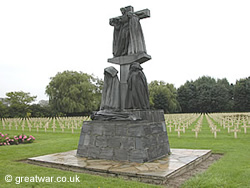Essex Farm Cemetery, Ypres (Ieper), Belgium
There are 1,200 WW1 servicemen buried or commemorated in this cemetery. Of these burials 103 are not identified. There are special memorials commemorating 19 casualties who are known or believed to be buried among the unidentified burials.
The cemetery was used by several British divisions holding this sector from 1915 to August 1917. Men from these divisons are buried throughout the cemetery. Plot I contains the dead of the 49th (West Riding) Division from 1915. The dead of the 38th (Welsh) Division dated in the autumn of 1916 are buried in Plot III.
After the war the cemetery was designed by Sir Reginald Blomfield.
Origins of Essex Farm Cemetery
French Army Burials
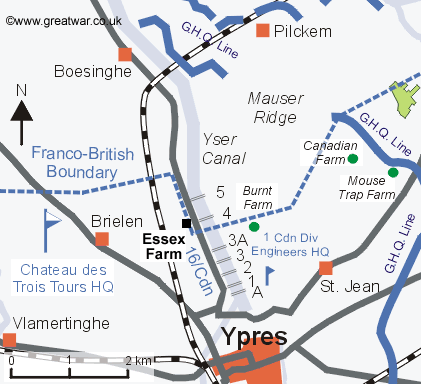
|
The burials on the site of this British military cemetery were begun by the French Army during the First Battle of Ypres (19 October - 22 November 1914).
The French Army was occupying this sector of the Allied Front Line north of Ypres (Ieper) until mid April 1915. The French war dead who were buried here were removed after the First World War and reburied in a French military cemetery. It is likely that they were re-interred in the French cemetery located in the northern part of the Ypres Salient named Saint-Charles-de-Potyze.
British Army Takes Over from April 1915
On 17 April 1915 the British Army extended the Front Line it was holding in the Ypres Salient, taking over a section of Front Line from the French Army to the east of Langemarck. The rear area behind the Front Lines and north of Ypres around Essex Farm, on the western bank of the Ypres-Yser canal, was also taken over by the British Army.
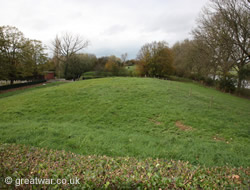
|
Only a few days later the German Army launched an attack with gas and the Second Battle of Ypres began. Canadian field guns were brought to the western canal bank to assist with the defence of the sector by the British and French Armies.
Essex Farm was located on the western end of Bridge Number 4, also known as Brielen Bridge. The village of Brielen was a few kilometres to the west of this bridge.
It was from this time that the Canadian field artillery established a small, basic dressing station near Essex Farm to tend to wounded casualties in the vicinity. British casualties who died near to the location of Essex Farm were buried in this cemetery.
Advanced Dressing Station in the Ypres-Yser Canal Bank
Dugouts in the Spoilbank
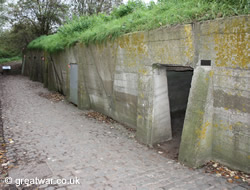
|
Initially a British medical post located here was simply a number of dugouts cut into the spoilbank of the western (left) side of the canal.
Concrete Shelters
Gradually over the years as the war went on into years the Advanced Dressing Station (A.D.S.) located in this position west of the canal was developed by the British Army into a number of concrete shelters. These provided better protection against enemy artillery fire or aerial bombing.
To find out more about the Dressing Station, to see a drawing of the plan of the bunker and the preserved bunker that you can visit today see our page at:
Essex Farm Advanced Dressing Station (A.D.S.)
15 Years Old: Rifleman Valentine Joe Strudwick
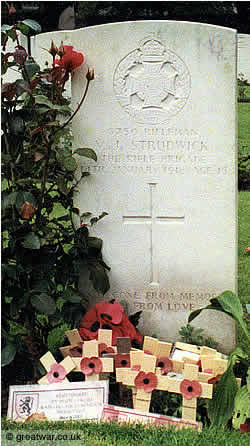
|
Rifleman Valentine Joe Strudwick, Service Number 5750, serving with 8th Battalion The Rifle Brigade, was aged 15 when he died on 14 January 1916. He is one of the youngest British casualties of the Great War to die in action.
This boy soldier was the son of Louisa Strudwick of 70, Orchard Road, Dorking, Surrey.
His final resting place is to be found in Essex Farm Cemetery at Grave Reference: Plot I. Row U. Grave 8.
49th (West Riding) Division Memorial
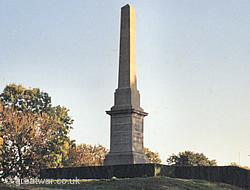
|
The 49th (West Riding) Division Memorial is located at the eastern boundary of Essex Farm cemetery on the western bank of the Ieper-Ijser (Ypres-Yser) canal.
This division served in this sector in 1915.
“In Flanders Fields the poppies blow...”
The location of Essex Farm Advanced Dressing Station (A.D.S.) is believed to be the place in May 1915 where the Canadian Army Doctor and artillery brigade commander Major John McCrae composed his famous poem “In Flanders Fields”.
The red poppies growing in the warm spring weather, amongst the military graves near to the makeshift medical bunker he was working in at that time, are believed to have been the inspiration for the poem. The symbol of the red poppy and the death of a friend, Lieutenant Alexis Helmer, deeply affected John McCrae during the time of his involvement in the Second Battle of Ypres.
Find out more about how John McCrae was inspired to write the poem in the early days of this battle:
Inspiration for “In Flanders Fields” poem by John McCraeLocation of Essex Farm Cemetery
Essex Farm Cemetery, Diksmuidseweg, 8900 Ieper, Belgium
Latitude 50.871341; Longitude 2.872681
The cemetery is located on the east side of Diksmuidseweg (the N369 Ieper - Boezinge road), about 1.5 kilometres north of Ieper (Ypres).
Parking
A parking area next to the cemetery and off the main carriageway has parking space for a few cars and/or a couple of coaches. Visitors are advised to take great care when moving around parked vehicles as passing traffic on this road may be travelling fast.
Related Battle Study
Battle Study: The Second Battle of Ypres, 1915
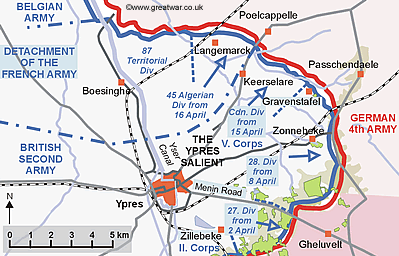
|
For more detail on the arrival of the British and Commonwealth Forces in this part of the Ypres Salient see our featured Battle Study on the build-up to the German trial of gas and the first hours of what became known as the Second Battle of Ypres:
The Second Battle of Ypres, 1915
Pages of the Study related to the Canadian Division moving into the Ypres Salient sector at this time are:
1st Canadian Division Completes the Relief of French 11 Division and 1st Canadian Field Artillery Moves from the Reserve
Related Topics
Saint-Charles-de-Potyze French Military Cemetery
The French casualties originally buried at the Essex Farm Cemetery location were moved to the French National Military Cemetery north of Ypres after the war:
Saint-Charles-de-Potyze French Military Cemetery
Acknowledgements
Commonwealth War Graves Commission (CWGC): The CWGC cares for Essex Farm Cemetery. To find out more about the work of the Commission, for education resources and to search for the burial or commemorated location of a person who fell in the 1914-18 war visit the CWGC website.
Some of the cemetery description and history has been sourced by kind permission of The Commonwealth War Graves Commission (CWGC). For more information about the cemeteries and the work of the commission visit the CWGC website:
Website: www.cwgc.org


